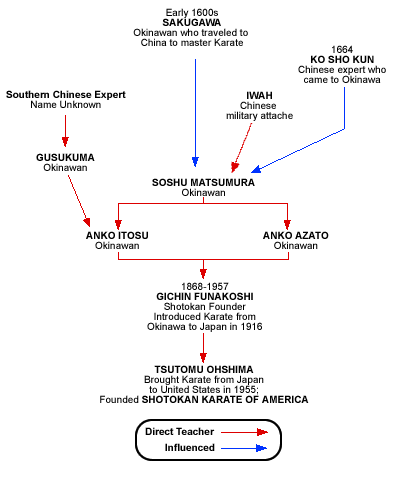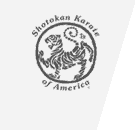|
Karate
history can be traced back some 1400 years, to Daruma, founder
of Zen Buddhism in Western India. Daruma is said to have introduced
Buddhism into China, incorporating spiritual and physical
teaching methods that were so demanding that many of his disciples
would drop in exhaustion. In order to give them greater strength
and endurance, he developed a more progressive training system,
which he recorded in a book, Ekkin-Kyo, which can be considered
the first book on karate of all time.
The
physical training, heavily imbued with Daruma's philosophical
principles, was taught in the Shaolin Temple in the year 500
A.D. Shaolin (Shorin) kung-fu, from northern China, was characterized
by very colorful, rapid, and dynamic movements; the Shokei
school of southern China was known for more powerful and sober
techniques. These two kinds of styles found their way to Okinawa,
and had their influence on Okinawa's own original fighting
method, called Okinawa-te (Okinawan hand) or simply te. A
ban on weapons in Okinawa for two long periods in its history
is also partly responsible for the high degree of development
of unarmed fighting techniques on the island.
In
summary, karate in Okinawa developed from the synthesis of
two fighting techniques. The first one, used by the inhabitants
of Okinawa, was very simple but terribly effective and, above
all, very close to reality since it was used throughout many
centuries in real combat. The second one, much more elaborate
and impregnated with philosophical teachings, was a product
of the ancient culture of China. These two origins explain
the double character of Karate--extremely violent and efficient
but at the same time a strict and austere discipline and philosophy
with a nonviolent emphasis. 
The
Influence of Master Funakoshi
Master
Gichin Funakoshi was the first expert to introduce karate-do
to mainland Japan, in 1916. One of the few people to have
been initiated into all the major Okinawan karate methods,
Master Funakoshi taught a synthesis of the Okinawan styles,
as a total discipline. This method became known as Shotokan
(literally "House of Shoto," Funakoshi's pen name).
Because of the great popularity of the style in Japan and,
later, around the world, Funakoshi is widely considered to
be the "father of modern karate-do."
The Influence of Tsutomu Ohshima
Tsutomu
Ohshima was one of Master Funakoshi's last direct pupils
(1948-1953), studying under him while attending Waseda University
in Tokyo, Japan. In 1955 Mr. Ohshima came to the United States
and was the first person to teach karate to the US public.
By 1959 the Southern California Karate Association (SCKA)
was formed, which has grown over the years to become a nationwide
organization, Shotokan Karate of America, and Mr. Ohshima's
influence on karate is felt around the world.
Despite
the secluded nature of Mr. Ohshima's early US practices, knowledge
of his teachings quickly spread and membership steadily increased.
In August of 1957 Mr. Ohshima was asked to demonstrate Karate
during the intermission of the annual Nisei Week Judo Tournament,
held in Koyasan Hall in Little Tokyo, Los Angeles. This was
the first public demonstration of traditional Shotokan karate
in the United States, and has since become an annual SKA activity.
In 1958 a separate karate tournament was added as part of
Nisei Week under the direction of Mr. Ohshima. The Nisei Week
tournament is now the oldest annually held karate tournament
in the United States, and is still presided over by Mr. Ohshima.
In
addition to the formation of the SCKA, several other events
of historical importance to Shotokan Karate of America occurred
in 1959. In July the first US Special Training was held. In
December Mr. Ohshima awarded six of his students the rank
of shodan (first degree black belt), making them the first
American-trained black belts in Shotokan karate. (These honored
six were Caylor Adkins, George Murakami, Mas Norihiro, Jordan
Roth, Roe Suzuki, and George Takahashi.)
In
1960, three years after the death of Master Funakoshi in Japan,
Mr. Ohshima led the Waseda Karate Club black belts on a tour
of Okinawa and its karate experts. This was the first official
visit by students from the Japanese mainland since before
the Second World War.
A
key event in the history of US karate occurred in 1967 when
Mr. Ohshima brought the first organized group of karateka
(karate practitioners) from America to tour and demonstrate
in Japan. During their two weeks in Japan, this group of 36
black, brown, and white belts (including two from Canada and
two from Europe) left a strong impression of the high degree
of development that karate had attained in the United States.
This visit created much interest in American karate among
Mr. Ohshima's seniors in Japan. In 1968 Mr. Ohshima invited
Senior Isao Obata, the first Captain of the Keio University
Karate Club, to the United States. During his stay Senior
Obata personally observed and educated Mr. Ohshima's students.
In
1970 five SKA members (John Beltram, Don DePree, Jeff Klein,
Ron Thom, and Henry Wilkerson) were honored by being selected
to the United States team representing America in the first
World Karate-do Championships held in Tokyo, Japan. Their
outstanding performance enhanced the international reputation
of Shotokan Karate of America.
Another
visit of major importance from Japan occurred in 1973, when
Mr. Ohshima and SKA invited Senior Shigeru Egami to the United
States. SKA organized a massive demonstration for Senior Egami,
and he honored us by lecturing and educating our members.
During
1975, because of SKA's committed involvement with the Amateur
Athletic Union, the entire responsibility for the Third World
Karate-do Championships was thrust upon us. Participants from
35 countries traveled to Long Beach, California, for the event.
It was an enormous and difficult task, but it ultimately enhanced
our goal of spreading the 'way' of karate by increasing communication,
heightening understanding of karate, and gaining constructive
viable relationships with martial artists and leaders from
all parts of the globe.
In
1975 SKA invited Senior Tadao Okuyama to visit the United
States to observe our members. He also personally led Mr.
Ohshima in daily practices.
To
commemorate our 20th anniversary in 1976 SKA held a memorable
celebration, including a public demonstration and tournament.
High-ranking karate experts from all over the world came to
honor the occasion. Various speeches and awards were made,
including a presentation to Mr. Ohshima of a special plaque
by Councilman Bob Farrell on behalf of the City of Los Angeles
for his unselfish devotion to karate, his students, and the
public for over twenty years. We were especially honored by
the presence of Senior Kamata-Watanabe from Japan, who accepted
our invitation to attend. Senior Kamata-Watanabe spoke to
our members, emphasizing that all members of SKA should be
proud of our association with Mr. Ohshima for his work over
the last twenty years in developing the strongest and most
traditional karate organization following the teachings of
Master Funakoshi.
The
highlight of the 20th anniversary took place at the special
dan (black belt rank) promotion personally administered by
Senior Kamata-Watanabe with Mr. Ohshima at the Melrose Dojo
in Los Angeles. In the tense atmosphere of the dojo crowded
with SKA black belt observers, three men (Caylor Adkins, Sadaharu
Honda, and Daniel Chemla) became the first individuals outside
of Japan to be awarded the rank of godan (fifth degree black
belt), the highest that can be achieved. This event marked
the coming of age of Shotokan Karate of America!
|




